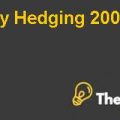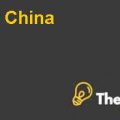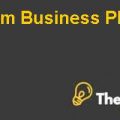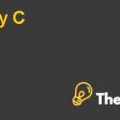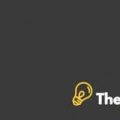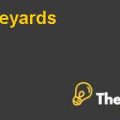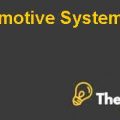Anandam Manufacturing Company Case Study Solution
Introduction
Agarwal is the owner of the Anandam Private limited which is a Garment Manufacturing Company.Due to funding issues Agarwal currently approached the bank for additional funding of INR 50millionfor which he have submitted a detailed proposal and the Bank have put his request of loan on Process.
Agarwal and his wife are the only shareholders of the Company, and they had pledged their assets of Anandam for the loan of INR 25 million for their business and due to difficulty in procuring loan Agarwal has also provided collateral security of his residence. Agarwal has worked for 12 years in a local garment manufacturing company and is a qualified engineer.
India was the second largest producer of garments in the world garment industry having acompound annual growth rate of 13% over the next 10 year period. Agarwal was familiar with the complete process of garment manufacturing and he also recruited Ragini to resolve his problem.Anandam has continuous growth because of the new creative design, good quality fabrics and fine furnishing details and there is a sizeable share of the market available which is yet to becaptured.
Agarwal is in need of new machines, larger location and new skilled laborers and some additional staff members, he’seagerly waiting for thedecision pending by the bank for the approval of hisloan request.
Problem statement
Agarwal has no particular knowledge of how to deal with the financial dynamics of the business which is also one of the reasons for funding issues. Unavailability of funds leads Anandam towards having low working capital for the regular purchase of raw material; the customers have more stress on credit rather than cash and the unfulfilled requirement of new machinery and insufficient space in the factory.
Company have observed stock piling up in the factory which does not dispatch, or the customer delayed the delivery causing lack of space in the factory.
The high threat of new entrants in which the newcomers have easy gateway strategycapturingan attractive market withno obstacles. This leads international players entering towards Indian textile market.
Not only the Company but also the overall Indian textile industry face insufficiencies like shortage of skilled laborer and energy, and transportation cost, etc.
An Analysis of the statement of Cash flow for Anandam
The cash position of Anandam has reached to INR 106,000 from INR 40,000 which shows a significant increase of165% in two years.
While comparing the performance of 2014 with 2015, there is only increase of INR 6,000 at FY2015,but there is significant movement in cash inflows and outflows during the year.
It looks like Anandam constantly focuses on improving his cash earnings from operations yearly as there is extreme change among revenues in each of the year.
Anandam has invested thehigh amount in property plant and equipment in two years which have to increase the fixed assets by approximately 150%. However, Agarwal still needs the new machines which will in future take into effect the graph of investment. Agarwal have already unfavorable ratio of return on fixed asset, fixed asset turnover and total asset turnover in comparison with the industry’saverage of key ratios, therefore, it is possible that Agarwal may have a right motive or the machines are not effective.
Since the Anandam not only invested significantly on fixed assets but also faced high operational charges and three times higher creditor limit compared to last year due to which the company is facing financial liquidity and funding problem which eventually result in amplified long-term liability.
Common sizing the Balance Sheet and Income Statement
| 2013 | 2015 | 2013 | 2015 | |
| Figures are in thousand | ||||
| Sales | 200 | 800 | 10% | 10% |
| Cash Credit | 1,800 | 7,200 | 90% | 90% |
| Total sales | 2,000 | 8,000 | 100% | 100% |
| Cost of goods sold | 1,240 | 4,800 | 62% | 60% |
| Gross profit | 760 | 3,200 | 38% | 40% |
| Operating expenses: General, administration. and selling expenses Depreciation Interest expenses (on borrowings) |
240 | 2,000 | 12% | 25% |
| Profit before tax (PST) | 520 | 1,200 | 26% | 15% |
| Tax 30% | 156 | 360 | 8% | 5% |
| Profit after tax (PAT) | 364 | 840 | 18% | 11% |
| Balance sheet | 2013 | 2015 | 2013 | 2015 |
| Figures are in thousand | ||||
| Assets | ||||
| Fixed assets (net of depreciation) | 1,900 | 4,700 | 74% | 51% |
| Current assets | ||||
| Cash and cash equivalents | 40 | 106 | 2% | 1% |
| Accounts receivable | 300 | 2,100 | 12% | 23% |
| Inventories | 320 | 2,250 | 13% | 25% |
| Total | 2,560 | 9,156 | 100% | 100% |
| Equity & Liabilities | ||||
| Equity share capital (shares of | ||||
| Z10 each) | 1,200 | 2,000 | 47% | 22% |
| Reserve & surplus | 364 | 1,876 | 14% | 20% |
| Long-term borrowings | 736 | 2,500 | 29% | 27% |
| Current liabilities | 260 | 2,780 | 10% | 30% |
| Total | 2.560 | 9,156 | 100% | 100% |
Calculation of trend analysis among the present year
| 2013 | Growth in 2013 to 2014 | 2014 | Growth in 2014 to 2015 | 2015 | |
| Cash | 200 | 140% | 480 | 67% | 800 |
| Credit | 1,800 | 140% | 4,320 | 67% | 7,200 |
| Total sales | 2,000 | 140% | 4,800 | 67% | 8,000 |
| Cost of goods sold | 1,240 | 128% | 2,832 | 69% | 4,800 |
| Gross profit | 760 | 159% | 1,968 | 63% | 3,200 |
| General, administration, and selling expenses | 80 | 463% | 450 | 122% | 1,000 |
| Depreciation | 100 | 300% | 400 | 65% | 660 |
| Interest expenses (on borrowings) | 60 | 163% | 158 | 115% | 340 |
| Profit before tax (PST) | 520 | 85% | 960 | 25% | 1,200 |
| Tax (. 30% | 156 | 85% | 288 | 25% | 360 |
| Profit after tax (PAT) | 364 | 85% | 672 | 25% | 840 |
This is just a sample partial work. Please place the order on the website to get your own originally done case solution.

